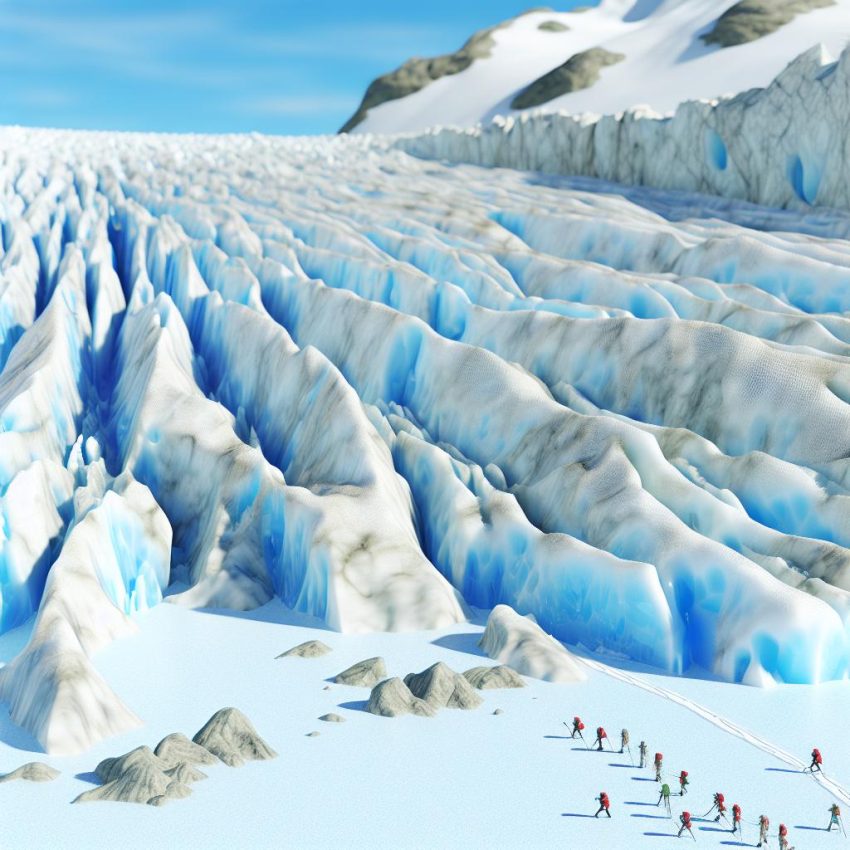Introduction to Glacier Hiking
Glacier hiking, also referred to as glacier trekking, is a distinctive outdoor pursuit that involves navigating massive expanses of ice. Found predominantly in polar and mountainous regions worldwide, glaciers offer a fascinating landscape that hikers can explore. This activity enables adventurers to experience stunning vistas and engage in an exhilarating journey across these colossal frozen terrains.
Understanding Glaciers
A glacier is essentially a thick accumulation of ice that originates from compacted snow over extended periods. Contrary to static perceptions, glaciers are dynamic, slowly moving across the earth’s surface. They play a pivotal role in sculpting the geographical features around them through the processes of erosion and deposition. Generally located in arctic zones and high-altitude regions, glaciers persist where temperatures remain low enough year-round to prevent snow from melting entirely.
Types of Glaciers
Though glaciers might seem homogeneous from afar, they can be categorized into distinct types based on their formation and location. Understanding these differences enhances appreciation when undertaking glacier hiking.
Valley Glaciers: These glaciers are primarily formed in mountainous valleys. Over time, they extend downhill, often carving out U-shaped valleys in their path. Their relentless movement through these valleys creates distinctive landscapes that captivate geologists and adventurers alike.
Continental Glaciers: Representing a more extensive form than their valley counterparts, continental glaciers, also known as ice sheets, encompass vast areas of land. Their sheer size dominates large geographical regions, particularly in Antarctica and Greenland, influencing local and global climates.
Safety Considerations
Engaging in glacier hiking necessitates a keen awareness of safety due to the potential hazards involved in these challenging environments. Proper precautions and preparations are imperative for a successful and secure hiking experience.
1. Proper Equipment: Utilizing specialized gear is crucial for glacier hiking. Essential tools like crampons, ice axes, helmets, and harnesses enable hikers to maintain stability on icy surfaces and offer protection against unforeseen slips and falls. The correct equipment significantly enhances both safety and confidence while maneuvering through potentially treacherous conditions.
2. Weather Conditions: Monitoring the weather is of utmost importance since glaciers are particularly sensitive to climatic changes. Adverse weather conditions such as poor visibility or extreme cold can exacerbate risks. Thoroughly assessing weather forecasts before embarking on a hike is necessary to ensure preparedness and adapt plans accordingly.
3. Guided Tours: Seeking guidance from professional guides is highly recommended, especially for those unfamiliar with glacier environments. Experienced guides possess the expertise required to navigate challenging terrains, impart essential safety knowledge, and create a more enriching hiking experience.
Ecological Impact and Conservation
Glaciers serve as vital indicators of climate change, adapting significantly to fluctuations in global temperatures. The ongoing phenomenon of glacial retreat, attributed to rising temperatures, poses substantial threats to freshwater resources and consequently influences global sea levels. Preservation efforts are directed towards mitigating human-induced climate influences to conserve these essential natural features.
By fostering a deeper understanding and respect for the unique glacier environment, hiking enthusiasts can enjoy this exceptional activity responsibly, while actively contributing to conservation initiatives. Glacier hiking not only provides a physical challenge but also offers insights into Earth’s climatic history through the examination of these majestic ice formations. It presents a remarkable opportunity for nature lovers and adventure seekers to connect with and appreciate the fragile yet profoundly influential glacier ecosystems we strive to protect.
Exploring glaciers on foot transcends a mere recreational activity; it engages participants in a fuller awareness of the planet’s environmental cycles. It represents an intersection of adventure and science, drawing enthusiasts who are eager to expand their knowledge and push their personal boundaries. Despite its demands, glacier hiking is a rewarding venture that leaves an indelible mark on those who undertake its challenges, enriching their understanding of the natural world and their place within it.
For those interested in taking up glacier hiking, there are myriad destinations across the globe offering varying levels of difficulty and unique sights. Countries like Iceland, New Zealand, Norway, and the United States offer organized glacier treks that suit all levels of experience. Each location presents diverse features ranging from crevasses and icefalls to ice caves and seracs, ensuring an unforgettable exploration of breathtaking icy landscapes.
Navigating a glacier underlines the stark reality of environmental changes, impressing upon participants the importance of conservation. These experiences have a transformative power, inspiring many hikers to advocate for environmental stewardship and sustainability.
As the world’s climates continue to evolve, appreciating and preserving these natural wonders becomes ever more pressing. Engaging in glacier hiking fosters not only a personal connection with these magnificent formations but also promotes a collective responsibility towards ensuring their persistence for future generations. In doing so, it aligns the thrill of adventure with the commitment to safeguard our planet’s delicate ice heritage.
Whether you are an avid hiker or merely curious about glaciers, stepping onto these icy giants is an expedition that promises awe and introspection. Through an understanding of their significance and a commitment to respectful exploration, glacier hiking becomes a pathway to celebrate and protect the delicate balance of our planet’s ecosystems.

